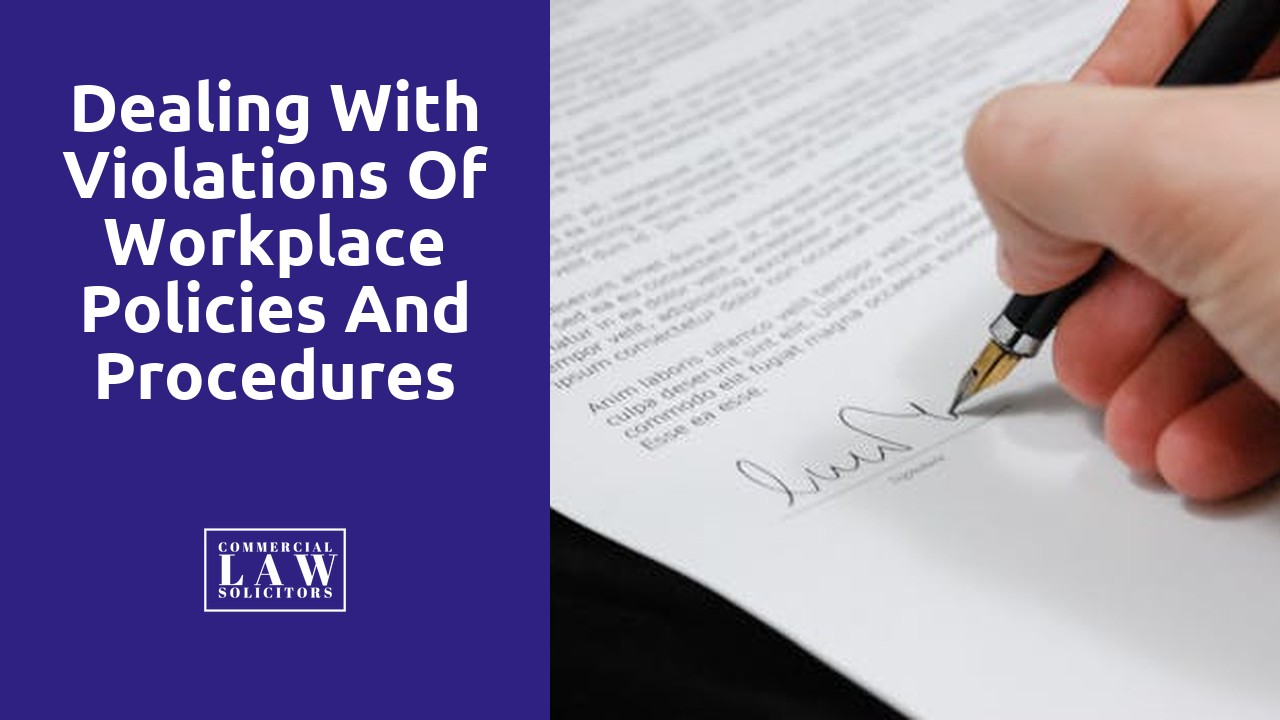Dealing with Violations of Workplace Policies and Procedures

Addressing Breaches: Navigating Workplace Policy Infractions
To effectively address breaches of workplace policy, it is essential for organizations to have clear guidelines in place. These policies should outline the expected behavior and conduct of employees, ensuring a harmonious and productive work environment. By establishing these standards, employers can effectively navigate and address policy infractions in the workplace.
When faced with a policy violation, it is crucial for organizations to approach the situation with a balanced and fair mindset. It is important to gather all relevant information and evidence before taking action, in order to make an informed decision. This may involve conducting investigations, interviewing relevant parties, and reviewing any applicable documentation or records. By following a thorough and objective process, employers can address breaches of policy in a manner that upholds standards and promotes accountability among employees.
Upholding Standards: Managing Employee Conduct in the Workplace
Managing employee conduct in the workplace is crucial for upholding organizational standards and promoting a positive work environment. It involves setting clear expectations, establishing policies and guidelines, and enforcing them consistently. By doing so, employers can ensure that employees understand the company's values and behave in a manner that reflects those values.
To effectively manage employee conduct, it is important to establish a code of conduct that outlines expected behaviors and consequences for policy violations. This code should be communicated to all employees through training programs, handbooks, and regular reminders. Additionally, managers and supervisors should lead by example, demonstrating the desired behaviors and addressing any inappropriate conduct promptly and fairly. By upholding these standards consistently, employers can create a workplace culture that promotes professionalism, respect, and productivity.
Maintaining Order: Addressing Policy Violations in the Corporate Environment
When it comes to maintaining order in the corporate environment, addressing policy violations is essential. Policies and guidelines are put in place to ensure a productive and harmonious workplace, and it is crucial that they are upheld and enforced consistently. Addressing policy violations promptly and effectively not only promotes a culture of accountability, but also helps to prevent further breaches and maintain order in the organization.
One approach to addressing policy violations is through clear communication and education. Employees should be made aware of workplace policies and guidelines from the onset, through proper orientation and regular training sessions. Providing employees with a comprehensive understanding of the policies and the consequences of violating them can help deter potential breaches. It is important to create an open and approachable environment where employees feel comfortable reporting policy violations and seeking clarification when needed. By fostering a culture of open communication and continuous learning, organizations can effectively address policy violations and maintain order in the corporate environment.
Establishing Accountability: Handling Breaches of Workplace Guidelines
Handling breaches of workplace guidelines is an essential aspect of establishing accountability within an organization. When an employee disregards these guidelines, it not only undermines the integrity of the workplace but also poses potential risks to the overall productivity and well-being of the entire team. Therefore, it is crucial for companies to have a robust system in place for addressing and managing such infractions.
One effective strategy for handling breaches of workplace guidelines is to clearly communicate the policies to all employees from the outset. By ensuring that everyone is aware of the expectations and consequences for non-compliance, organizations can establish a culture of accountability. Additionally, providing regular training and refresher courses can help reinforce these guidelines and keep them fresh in employees' minds. This approach promotes transparency and helps employees understand the importance of following the established policies, ultimately reducing the likelihood of breaches occurring in the first place.
Resolving Disruptions: Strategies for Dealing with Workplace Policy Infringements
One of the key strategies for resolving disruptions caused by workplace policy infringements is to implement a clear and comprehensive disciplinary process. This process should outline the steps that will be taken when an employee violates company policies, ensuring that there are consistent consequences for their actions. By establishing a fair and transparent system, employees will understand the potential repercussions of their behavior, which can deter future infractions and promote compliance with workplace regulations. It is important for organizations to communicate the disciplinary process to all employees, ensuring that they understand the expectations and consequences. This can be done through regular training sessions, employee handbooks, and clear communication channels between managers and staff members.
Promoting Compliance: Strategies for Enforcing Workplace Regulations
In order to promote compliance with workplace regulations, it is crucial for organizations to establish clear guidelines and expectations for their employees. This can be achieved through the development and implementation of comprehensive policies and procedures that outline the rules and standards that must be adhered to. By providing employees with a detailed understanding of what is expected from them, organizations can create a culture of compliance where individuals are aware of their responsibilities and are motivated to meet the established requirements.
Another effective strategy for enforcing workplace regulations is through regular training and education sessions. By providing employees with the necessary knowledge and skills to understand and comply with the regulations, organizations can empower their workforce to make informed decisions and take appropriate actions. These training sessions can cover a wide range of topics, including the specific regulations that apply to the organization, procedures for reporting violations, and consequences for non-compliance. Additionally, organizations can leverage various training methods such as e-learning modules, workshops, and seminars to cater to different learning styles and preferences. By investing in ongoing training and education, organizations can ensure that their employees are well-equipped to comply with workplace regulations.
Related Links
Addressing Employee Questions and Concerns about Workplace Policies and ProceduresEnsuring Compliance with Workplace Policies and Procedures
Handling Workplace Policy and Procedure Disputes and Resolutions
Training Employees on Workplace Policies and Procedures
Best Practices for Reviewing and Updating Workplace Policies and Procedures